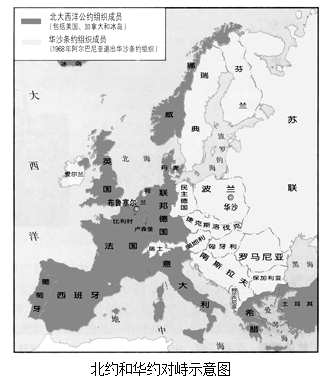(14分)冷战结束虽然已经过去20多年,但关于冷战起源的问题依然值得人 们深思。阅读下列材料:
材料一

材料二 苏联在坚决反对德国的军国主义和纳粹主义复活的同时,将其西部边界的安全视为关系民族和国家生死存亡的重大问题。斯大林在雅尔塔会议上对罗斯福和丘吉尔明确提出:“波兰问题对苏维埃国家来说是一个生死攸关的问题”。因此斯大林在三巨头的一系列会晤中对波兰问题始终寸步不让。不仅如此,苏联还坚决要在其军事力量所能控制的东欧的势力范围内建立对苏联友好的政府,从而把东欧这条入侵苏联的危险走廊变成保卫苏联的安全地带。
——齐世荣、彭树智《世界史·当代卷》
材料三 第二次世界大战后,美国采取攻势,导致了冷战。美国之所以采取进攻,……从政治上来说,美国政府的主要决策人极端仇视 * * 主义和苏联。从经济角度而言,美国资本家及其在政府中的代言人谋求世界对美国商业利益的开放。美国需要扩大海外市场以避免美国的经济陷于停滞和难以接受的失业。
——刘金质《冷战史》
材料四 冷战既不是苏联决策者也不是美国决策者制造的;既不是苏联的革命热情也不是美国的资本主义政治经济的必然结果。尽管冷战的参与者都不想要冷战,冷战最后还是发生了。这是因为战后的国际体系使苏联和美国决策者都感到对自己不利,他们都感到自己的国家安全受到自己所不能控制的力量的威胁。
——陶文钊《关于冷战起源的新解释》
请回答:
(1)据材料一,结合所学知识,指出二战后的世界政治格局及其形成的标志性事件。(2分)
(2)据材料二,分析苏联对西方国家态度强硬的主要目的。综合材料一、二,举例说明苏联把东欧变成“安全地带”的主要表现。(4分)
(3)结合所学知识,指出二战后美苏关系发生的变化。据材料三,概括美国挑起冷战的缘由。(4分)
(4)材料四认为冷战发生的原因是什么?据此指出作者采用的研究视角。综合上述材料,你认为在处理国际关系时应该遵循怎样的原则?(4分)
(1)格局:美苏两极格局。(1分)
标志:北约和华约的建立。(1分)
(2)主要目的:保障苏联西部边界的安全。(1分)
主要表现:在东欧建立对苏联友好的政府;扶植民主德国;组建华沙条约组织。(3分)
(3)变化:从同盟走向对抗。(2分)
缘由:发展资本主义经济的需要;对 * * 主义和苏联的仇视。(2分)
(4)原因:美苏领导人内心缺乏安全感。(1分)
视角:心态视角(或人物心理活动)。(1分)
原则:克服民族利己主义,树立平等价值观;加强合作互信,减少误判对抗。(2分)
题目分析:(1)依据所学知识,和图片信息可以得出战后世界格局为美苏两极格局,两极格局形成的标志为北约和华约的建立
(2)依据材料“苏联在坚决反对德国的军国主义和纳粹主义复活的同时,将其西部边界的安全视为关系民族和国家生死存亡的重大问题”可知其目的为了保障苏联西部边界的安全;依据“苏联还坚决要在其军事力量所能控制的东欧的势力范围内建立对苏联友好的政府”可得出在东欧建立对苏联友好的政府,结合所学得出扶植民主德国;组建华沙条约组织
(3)结合所学知识可知战后美苏关系有战时同盟关系到走向分裂对抗,美国冷战的原因为意识形态的差异,资本主义经济发展的需要和对 * * 主义和苏联的仇视。
(4)依据“他们都感到自己的国家安全受到自己所不能控制的力量的威胁”可以得出其共同原因为美苏领导人内心缺乏安全感,由此可知其视角为人物心理活动的角度,结合所学处理国际关系时应该遵循怎样的原则克服民族利己主义,树立平等价值观;加强合作互信,减少误判对抗等。
